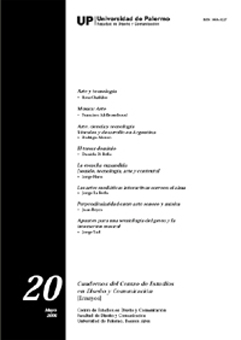Arte, ciencia y tecnología Vínculos y desarrollo en Argentina
Abstract
The relationship between arts, science and technology has a broad history.
After the Second Industrial Revolution, those fields were associated to economic and social progress, but in
the area of artists and intellectuals they would also embody aesthetic and utopian ideals. The artistic
vanguards of the 20th Century found in technology not only a tool for political and social change but also
a means for a complete transformation of art and people.
By the ‘60s, technological art was boosted. Its understanding is no longer utopian, but analytical and
conceptual. Artists are looking in it new ways to get near the world, without the need to change it.
The coming of video and –later on- computers boosts enormously the production, creating their own
circuits. Images expand towards the space, audiovisual productions explore new narratives. Digitalization
introduces novel possibilities for creation, manipulation and transformation of new or preexistent realities.
References
-Acconci, Vito. (1990) Television, Furniture, and Sculpture: The Room with the American View, en Hall, Doug; Fifer, Sally Jo (eds.). Illuminating Video. An Essential Guide to Video Art. New York; Seatle: Aperture: BAVC.
-Alonso, Rodrigo.
(2005) Hazañas y Peripecias del Video Arte en la Argentina, en Cuadernos de Cine Argentino 3. Innovaciones Estéticas y Narrativas en los Textos Audiovisuales. Buenos Aires: INCAA.
(1998-1999) Las Primeras Experiencias de Video Arte en Argentina, en Avances, 1 (2), Córdoba: Centro de Investigaciones de la Facultad de Filosofía y Humanidades (UNC).
(1998) A.Rodrigo - Taquini, Graciela.Buenos Aires Video X. Diez Años de Video en Buenos Aires. Buenos Aires: Ediciones ICI de Buenos Aires.
-Aristóteles.
(2000) Metafísica. Madrid: Biblioteca Clásica Gredos.
(1993) Ética Nicomaquea. En Aristóteles. Ética Nicomaquea, Ética Eudemia. Madrid: Biblioteca Clásica Gredos.
(1988) Mecánica. En Aristóteles. Sobre las Líneas Indivisibles. Mecánica; Euclides. Óptica. Catóptrica. Fenómenos. Madrid: Biblioteca Clásica Gredos.
-Aumont, Jacques et.al. (1986) Estética del Cine. Barcelona: Paidós.
-Brecht, Bertolt. (1984) Teoría de la Radio, en Brecht, Bertolt. El Compromiso en Literatura y Arte. Barcelona: Península.
-Bunge, Mario. (1969) La Investigación Científica. Su Estrategia y su Filosofía. Barcelona: Ariel.
-Glusberg, Jorge. (1985) Arte en la Argentina. Del Pop a la Nueva Imagen. Buenos Aires: Gaglianone.
GRAV. Stratégies de Participation. 1960-1968 (1998) (cat.exp.). Grenoble: Le Magasin. Centre d’Art Contemporain.
-King, John. (1985) El Di Tella. Buenos Aires: Gaglianone.
-Klüver, Billy (1994) Artists, Engineers, and Collaboration, en Bender, Gretchen; Druckrey, Thimothy. Culture on the Brink. Ideologies of Technology. Seattle: Bay Press.
-Kosice, Gyula. (1968) Arte Hidrocinético. Buenos Aires: Paidós.
-Kosuth, Joseph. (1969) Art After Philosophy, publicado
originalmente en Studio International, October 1969, reimpreso en Meyer, Ursula. Conceptual Art. New York: Dutton, 1972.
-Krauss, Rosalind. (1990) Video: The Aesthetics of Narcissism, en
Hanhardt, John. Video Culture. A Critical Investigation. New York: Visual Studies Workshop.
-Kuhn, Thomas. (2000) La Estructura de las Revoluciones Científicas. México: FCE.
-Latour, Bruno. Nunca Hemos Sido Modernos. Madrid: Debate, 1993.
-Lauria, Adriana (1995) Aproximación Hermenéutica a Simultaneidad en Simultaneidad de Marta Minujin, en Las Artes entre lo Público y lo Privado. VI Jornadas de Teoría e Historia de las Artes. Buenos Aires: CAIA.
-Lucio Fontana 1899-1968 (cat.exp.) (1988). Barcelona: Fundació Caixa de Pensions.
-Marinetti, Filippo Tommaso (1995) Il Teatro Futurista Aeroradiotelevisivo, citado en Malsh, Friedemann: Art et Video: Un Apreçu Historique, en 3º Biennale d’Art Contemporain de Lyon (cat.exp.). Paris: Réunion des Musées Nationaux.
-Medina, Manuel. (2000) Ciencia-Tecnología-Cultura del siglo XX al XXI. En Medina, Manuel; Kwiatkowska, Teresa (coord.). Ciencia, Tecnología / Naturaleza, Cultura en el Siglo XXI. Barcelona: Anthropos.
-Merleau Ponty, Maurice. (1984) Fenomenología de la Percepción. Barcelona: Planeta.
-Perazzo, Nelly. (1983) El Arte Concreto en la Argentina. Buenos Aires: Gaglianone.
-Platón. (1992) Filebo. En Platón. Diálogos VI. Madrid: Biblioteca Clásica Gredos.
-Pontus Hulten, K.G. (1968) Introduction, en Pontus Hulten, K.G. The Machine as Seen as the End of the Mechanical Age (cat.exp.). New York: The Museum of Modern Art.
-Popper, Frank. (1993) Art of the Electronic Age. New York: Harry Abrahams.
-Rizzo, Patricia. (1998) Instituto Di Tella. Experiencias ‘68. Buenos Aires: Fundación Proa.
-Romero Brest, Jorge. (1992) Arte Visual en el Di Tella. Buenos Aires: Emecé.
-Sanouillet, Michel; Peterson, Elmer (ed.). (1989) The Writings of Marcel Duchamp. New York: Da Capo Press.
-Verón, Eliseo. (1967) Sobre Marta Minujin. Un Happening de los Medios Masivos: Para un Análisis Semántico, en Masotta, Oscar et.al. Happenings. Buenos Aires: Jorge Alvarez.
-Vitruvio Pollión, Marco. (1978) De Arquitectura. Madrid: Albatros.
-Youngblood, Gene. (1970) Expanded Cinema. New York: Dutton.
Los autores/as que publiquen en esta revista ceden los derechos de autor y de publicación a "Cuadernos del Centro de Estudios de Diseño y Comunicación", Aceptando el registro de su trabajo bajo una licencia de atribución de Creative Commons, que permite a terceros utilizar lo publicado siempre que de el crédito pertinente a los autores y a esta revista.


